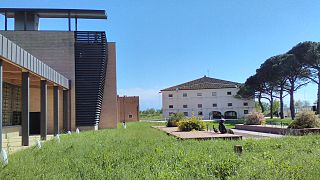
The National Archaeological Museum of Naples is an important Italian archaeological museum, particularly for ancient Roman remains. Its collection includes works from Greek, Roman and Renaissance times, and especially Roman artifacts from the nearby Pompeii, Stabiae and Herculaneum sites. From 1816 to 1861, it was known as Real Museo Borbonico.

The Egbert Psalter is a medieval illuminated manuscript Psalter preserved in the municipal museum of Cividale, Italy. The psalter is an example of the illuminated manuscripts associated with the Ottonian Renaissance.

Hermonax was a Greek vase painter working in the red-figure style. He painted between c. 470 and 440 BC in Athens. Ten vases signed with the phrase "Hermonax has painted it" survive, mainly stamnoi and lekythoi. He is generally a painter of large pots, though some cups survive.

Wedding Painter is the conventional name for an ancient Greek vase painter active in Athens from circa 480 to 460 BC. He painted in the red-figure technique. His name vase is a pyxis in the Louvre depicting the wedding of Thetis and Peleus.
Corpus Speculorum Etruscorum is an international project with the goal to publish all existing Etruscan bronze mirrors. The first three volumes were published in 1981. A total of thirty-six fascicles has been produced.

The Museo Nazionale della Magna Grecia, Museo Archeologico Nazionale di Reggio Calabria or Palazzo Piacentini is a museum in Reggio Calabria, southern Italy, housing an archaeological collection from sites in Magna Graecia.

Paolo Orsi was an Italian archaeologist and classicist.

The Palazzo Pretorio or Palazzo dei Provveditori veneti is a palace in Cividale del Friuli, northern Italy, attributed to the architect Andrea Palladio and built between 1565 and 1586. Since 1990 it is the home of the National Archeological Museum of Cividale.

The Taleides Painter was an Attic vase painter of the black-figure style, active in the second half of the 6th century BC. His conventional name is derived from his close cooperation with the potter Taleides, many of whose vases he painted. He also worked for the potter Timagoras.

The National Archaeological Museum is a museum located right on Piazza San Marco in Venice.

The Tarquinia National Museum is an archaeological museum dedicated to the Etruscan civilization in Tarquinia, Italy. Its collection consists primarily of the artifacts which were excavated from the Necropolis of Monterozzi to the east of the city. It is housed in the Palazzo Vitelleschi.

The Polo Museale del Lazio is an office of Italy's Ministry of Cultural Heritage. Its seat is in Rome in the Palazzo Venezia.
Museo Archeologico Nazionale di Campli is an archaeology museum in Campli, Abruzzo.

The National Archaeological Museum of Cagliari is a museum in Cagliari, Sardinia (Italy).

The National Archaeological Museum of Altino is an archaeology museum next to the archaeological site of Altinum. It is located in the frazione Altino of the municipality of Quarto d'Altino, in the Metropolitan City of Venice.

The National Archaeological Museum of Basilicata is an archaeological museum located in Potenza, Italy. It is located at the Palazzo Loffredo and holds objects discovered from excavations in the surrounding territory. It is dedicated to archaeologist Dinu Adameșteanu.

The National Archaeological Museum of Metaponto is a museum housing the archaeological finds from the Greek city of Metapontum, now Metaponto, Basilicata, Italy. It replaces the small Antiquarium built near the Heraion outside the walls of the Tavole Palatine.

The Giorgio Asproni National Archaeological Museum is an archaeological museum in the historic centre of Nuoro, in Sardinia, near the Cathedral of Our Lady of the Snows. Established in 2002, it is located in a nineteenth-century building that belonged to Giorgio Asproni, a Sardinian politician and intellectual of that era.

















